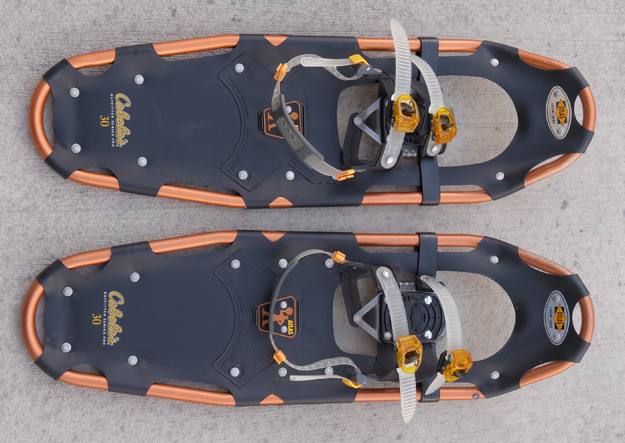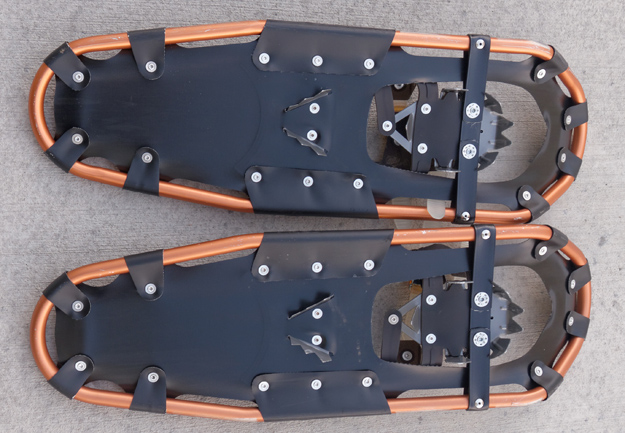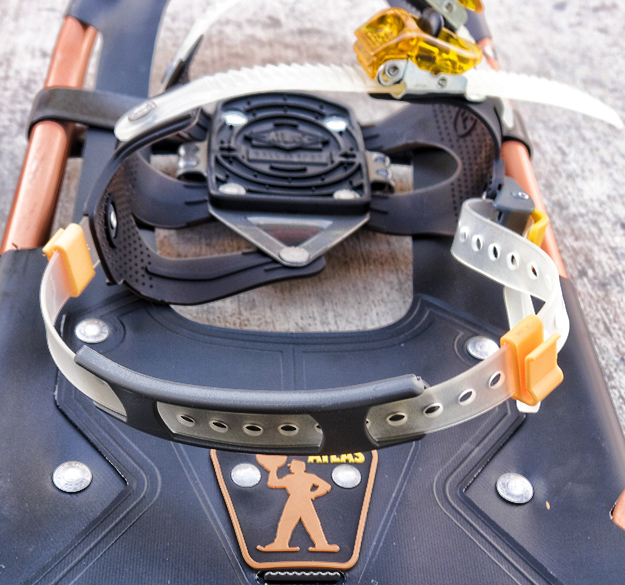Cabela’s Outfitter Pro Showshoes by Atlas — Medium (30 Inch) Size — Review
© 2014 Peter Free
07 February 2014


Adequate for moderate terrain and packed or shallow snow — but not for unpacked, deep snow
Cabela’s Outfitter Pro snowshoes (manufactured by Atlas) in the 30 inch size (250 pound maximum) have two significant flaws — inadequate floatation on deep snow and less than bomb-proof bindings.
I would not buy them again for deep Rocky Mountain snow or for survival situations.
Test conditions
Body and pack came to 205 pounds.
Temperature was minus 10 to 10 degrees Fahrenheit over the two days of the test, with light snow and wind gusts.
Rocky Mountain National Park, previously untracked snow.
Bindings
The Outfitter Pro bindings are made of stiffly flexible plastic strapping. The adjusters are difficult to operate with heavy gloves. Both bindings occasionally loosened during travel.

The rear strap (which goes around the boot heel) has a sliding piece that serves to locate where the heel should go. It slides on the strap, as it has to, to accommodate different boot sizes.

I found that my right boot heel (especially) began moving away from the longitudinal axis of the snowshoe, as the boot heel began sliding laterally inside the heel strap. As a result, the showshoe no longer tracked straight and would occasionally get caught under (or on top of) the left. On one occasion, this led to a headfirst fall down a very slight incline that injured me just enough to keep me sleepless that night.
Floatation — inadequate
I frequently sank up to knees and mid-thigh in deep snow with these snowshoes. My poles, equipped with ski baskets, often buried themselves to the handles.
After 2.5 to 3 hours of travel through forest and up a ridge, frequently fighting the lack of floatation, I was fairly tired.
Why these flaws matter
If you travel solo, you have to be cautious about overextending yourself. These snowshoes make that more difficult than they should for two reasons.
First, as I mentioned, the headfirst fall I took, due to the slipping right foot binding, led to mild but debilitating injuries.
The temperature at the time of the fall was below zero and the sun was about to set. As a result of the fall, snow managed to work its way under my clothing. Wet clothing, winter travelers know, is a bad thing.
Difficulty with adjusting the bindings also forced me to remove my gloves to correct the misalignment. Bare skin and snow do not go well together at low temperatures, particularly if you already have frostbite damage from years prior.
In sum, an unnecessary fall — due to poor equipment design — can lead to a mini-cascade of negative effects that may ultimately threaten survival.
Second, crappy snowshoe floatation makes deep snow travel really tiring. Although it does not sound especially difficult, having to clamber out of “post-holes” knee and thigh-deep with every step gets to you pretty quickly. As you try to take another step uphill, you are also fighting with the holed snowshoe’s tendency to slide backward. The same, in reverse, applies to going downhill.
Overall, under conditions like these, if you miscalculate your energy reserve, you can get into trouble by pressing on, when you should not. I had to turn back earlier than I had planned, due to the combination of fatigue and a strengthening snow storm. I was a little surprised at how tired I was, when I made it back to my car.
Would the 36 inch size help with floatation?
Not really.
Atlas stupidly mounted the bindings the same distance from the toe of the snowshoe in each of the 25, 30, and 36 inch sizes.
These means that the 36 inch snowshoe is not going to distribute the wearer’s weight evenly. Instead, the tail of the shoe is going to tilt upward, when the user steps forward and down into deep snow. The extra length, therefore, contributes virtually nothing to floatation and makes keeping one’s balance, in deep snow, even more problematic.
“Featherbender,” writing on Cabela’s website (on 25 November 2012), pointed to this design flaw. He indicated that he took — “several ‘heel over head’ tumbles because I’ve sunk forward into the snow.”
Other characteristics
These shoes lack a heel lift (which the Atlas 12 series has). A lift would have been helpful for some of steeper upslopes that I was on.
The snowshoes have a noticeable tendency to slide going downhill on soft snow. However, this is something one can easily compensate for, and I do not consider it to be a problem.
Traversing slopes on these, and other snowshoes, is difficult. The width of the shoe tends to want to conform to the slanted ground. Unlike skis, snowshoes are difficult (but not impossible) to edge. On steep terrain (for which the Outfitter Pros are not designed), I would recommend facing uphill and side-stepping.
Cabela’s Outfitter Pro snowshoes — not recommended for serious, trail-breaking conditions
These are not snowshoes to bet your life on. I would not buy another pair for unpacked, Rocky Mountain deep snow conditions.
 PeteFree.com
PeteFree.com